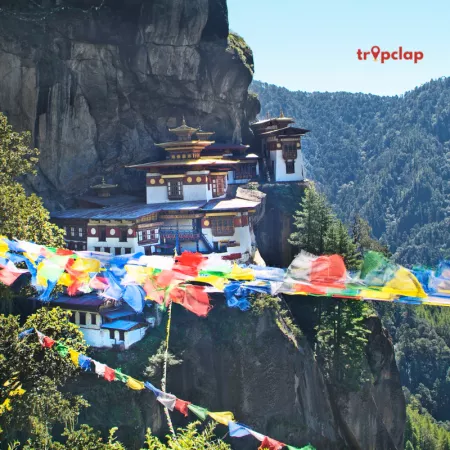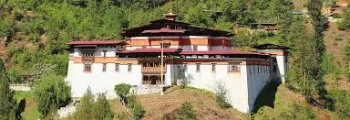
Paro
Duration
2 to 4 Days
2 to 4 Days
Best time to visit
Mar-May, Sep-Nov
Mar-May, Sep-Nov
Theme
Hill Station, Adventure, Religious
Hill Station, Adventure, Religious
Paro Travel Guide
Paro, located in the Kingdom of Bhutan, is a picturesque valley town known for its rich history, stunning landscapes, and vibrant culture. Nestled in the Himalayas, Paro is a popular destination for travelers seeking a unique and authentic experience in one of the world's most pristine environments. The town is famous for its sacred sites, including the iconic Tiger's Nest Monastery, which clings to a cliffside high above the valley.Top Attractions in Paro
- Tiger's Nest Monastery
- Paro Taktsang
- Paro Dzong
- National Museum of Bhutan
- Chele La Pass
Paro is Famous for
Paro is famous for its breathtaking natural beauty, ancient monasteries, and unique blend of traditional Bhutanese culture.Top Attractions in Paro
- Explore the iconic Tiger's Nest Monastery
- Visit the historic Paro Dzong
- Experience the stunning views from Chele La Pass
- Immerse yourself in Bhutanese history at the National Museum
What's Great about Travelling to Paro?
- Experience the peaceful and spiritual atmosphere of Bhutan
- Explore ancient monasteries and sacred sites
- Enjoy stunning Himalayan landscapes and pristine nature
What's Not So Great about Travelling to Paro?
- Limited tourist infrastructure and accommodations
- High altitude may pose challenges for some travelers
- Strict visa regulations and daily tourist fees
Travel Tips for Paro
- Obtain a visa and book tours through a licensed Bhutanese tour operator
- Respect local customs and traditions, such as dress codes and photography restrictions
- Be prepared for high altitude and fluctuating weather conditions
Important Paro trip information
- Ideal Duration: Plan to spend at least 3-4 days to explore Paro and its surrounding attractions.
- Best Time to Visit: The best time to visit Paro is during the spring and fall months for pleasant weather and clear skies.
- Nearby Airports and Railway Stations: Paro International Airport is the main gateway to Bhutan, and there are no railway stations in the country.
Per Person
25,980
*EXCLUDING APPLICABLE TAXES 4.9 Ratings
( 185 Reviews )
( 185 Reviews )
Per Person
20,700
*EXCLUDING APPLICABLE TAXES 4.6 Ratings
( 53 Reviews )
( 53 Reviews )
Per Person
28,200
*EXCLUDING APPLICABLE TAXES 4.6 Ratings
( 53 Reviews )
( 53 Reviews )
Per Person
39,399
*EXCLUDING APPLICABLE TAXES 4.6 Ratings
( 53 Reviews )
( 53 Reviews )
Per Person
25,970
*EXCLUDING APPLICABLE TAXES 4.9 Ratings
( 185 Reviews )
( 185 Reviews )
Per Person
17,700
*EXCLUDING APPLICABLE TAXES 4.6 Ratings
( 53 Reviews )
( 53 Reviews )
FAQ's on Paro
Q1: What is the best time to visit Paro?
The best time to visit Paro is during the spring months of March to May and the fall months of September to November. These periods offer pleasant weather, clear skies, and vibrant natural landscapes. Avoid the monsoon season from June to August due to heavy rainfall. Winter months from December to February can be cold but offer clear views of the snow-capped mountains.
Q2: Do I need a visa to travel to Paro?
Yes, travelers to Paro require a visa. Tourists can obtain a visa on arrival or apply in advance through the Bhutanese diplomatic missions. The visa process includes a visa fee and requires a confirmed booking with a Bhutanese tour operator. Exceptions may apply for Indian, Bangladeshi, and Maldivian citizens.
Q3: What are the must-visit attractions in Paro?
Paro is famous for attractions like Paro Taktsang (Tiger's Nest Monastery), Rinpung Dzong, National Museum of Bhutan, and Kyichu Lhakhang. The picturesque Paro Valley offers stunning landscapes for hiking, cultural experiences, and exploring Bhutanese architecture.
Q4: Is Paro a safe place to travel?
Paro is considered a safe destination for travelers. However, like any place, it's essential to be cautious and aware of your surroundings. Avoid isolated areas at night and take necessary precautions with your belongings. Follow local guidelines and respect the customs and traditions of the country.
Q5: What is the local currency in Paro and can I use credit cards?
The local currency in Paro is the Bhutanese Ngultrum (BTN). While credit cards are accepted in some hotels and larger establishments, it's advisable to carry cash for smaller purchases. ATMs are available in major towns like Paro, but it's recommended to carry enough cash for remote areas.
Q6: What is the local cuisine like in Paro?
Paro offers a unique culinary experience with dishes like Ema Datshi (chili and cheese stew), Phaksha Paa (pork with red chilies), and Momos (steamed dumplings). Local ingredients like red rice, buckwheat, and yak meat are commonly used. Vegetarian options are also available, and travelers with dietary restrictions can find suitable meals.
Q7: What transportation options are available in Paro?
Transportation in Paro includes taxis, buses, and rental cars. Taxis are convenient for short distances, while buses connect major towns. Rental cars are available with drivers for exploring the region. Additionally, bicycles and motorcycles can be rented for a more adventurous way to discover Paro and its surroundings.
Q8: Are there any cultural norms or etiquette I should be aware of when visiting Paro?
When visiting Paro, it's important to respect local customs and traditions. Dress modestly, especially when visiting religious sites. Always remove your shoes before entering temples and dzongs. Greet locals with a "Kuzuzangpo" (hello) and be mindful of photography restrictions in certain areas. Avoid public displays of affection and ask for permission before taking someone's picture. Embrace the peaceful and respectful demeanor of Bhutanese culture during your stay in Paro.
Q9: I am a travel agent. How can I buy travel leads of Paro?
Register yourself as a travel agent at agents.tripclap.com and then you can buy travel leads to Paro once your account is approved. For more details contact our support team at +91-8069186564 or support@tripclap.com







